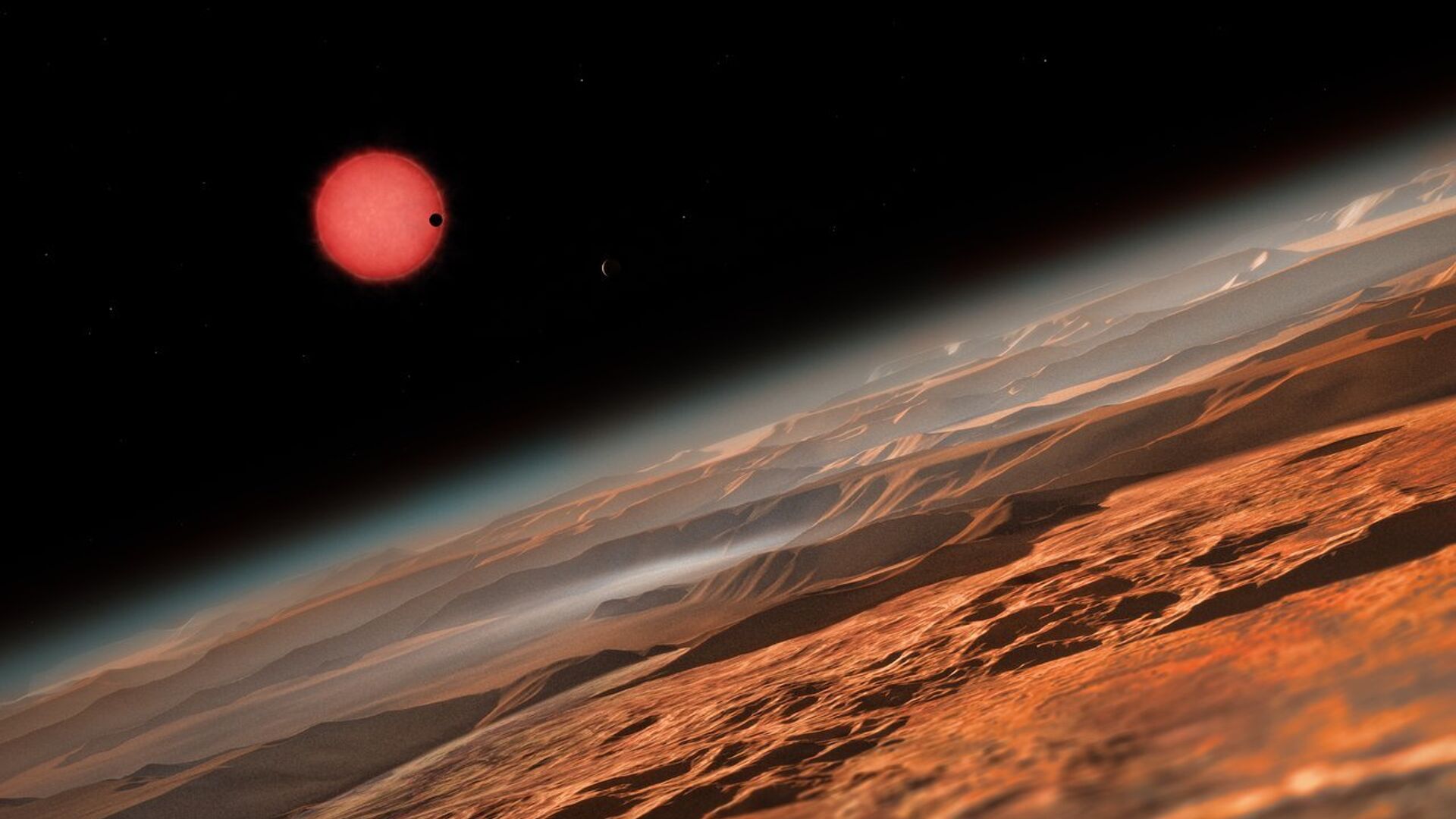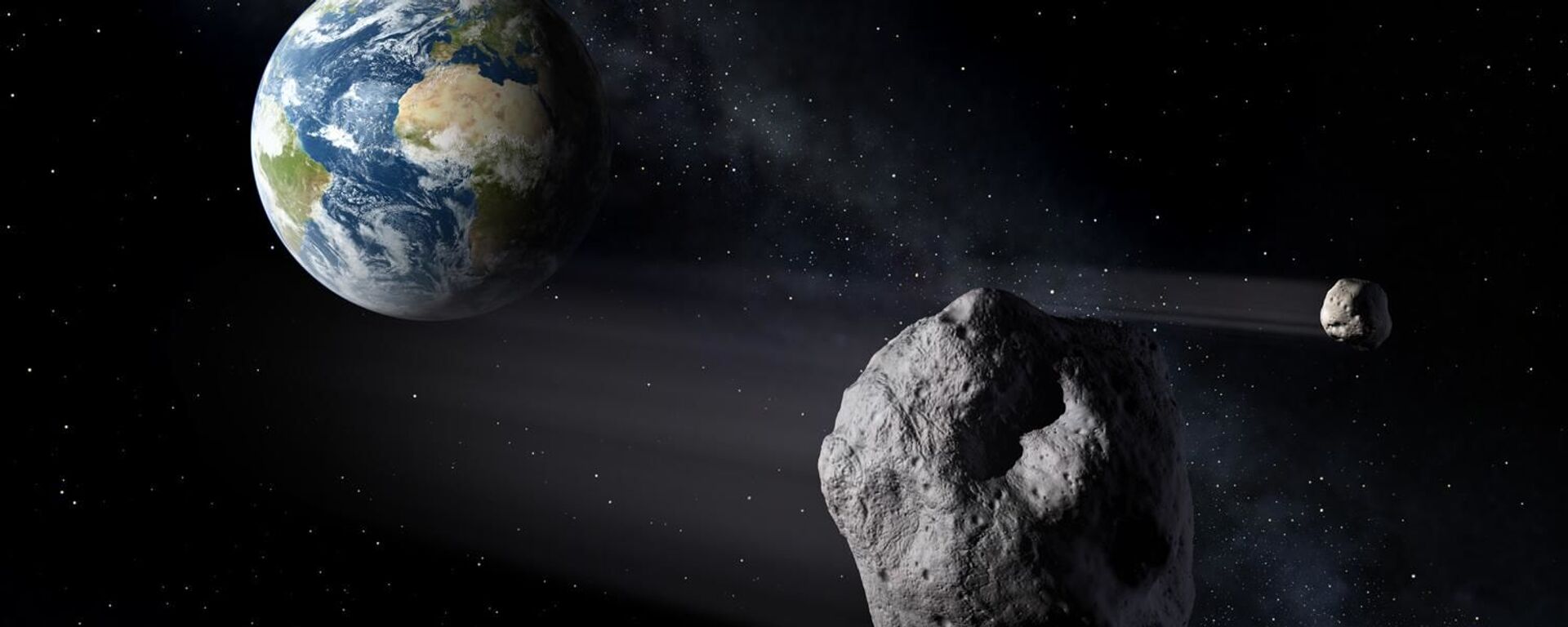https://sputnikglobe.com/20220604/astronomers-find-super-earth-four-times-bigger-than-ours-in-close-stars-habitable-zone-1095992066.html
Astronomers Find Super-Earth Four Times Bigger Than Ours in Close Star's 'Habitable Zone'
Astronomers Find Super-Earth Four Times Bigger Than Ours in Close Star's 'Habitable Zone'
Sputnik International
"Super-Earths" are planets with a mass greater than ours but less than that of Neptune. Although the term merely refers to the planet's mass, astronomers use... 04.06.2022, Sputnik International
2022-06-04T03:54+0000
2022-06-04T03:54+0000
2023-04-12T16:57+0000
science & tech
exoplanets
research
astronomy
earth
space
https://cdn1.img.sputnikglobe.com/img/103896/35/1038963541_0:73:1281:793_1920x0_80_0_0_c4e65f86b1052f538ef19c6854d02769.jpg
A four-times-larger-than-our-planet "super-Earth" has been discovered orbiting a star just 36.5 light-years away. However, according to new research by the international team of astronomers using the National Astronomical Observatory of Japan's Subaru Telescope in Hawaii, despite being in the so-called "Goldilocks" zone, where the temperature is just enough for liquid water to exist, experts believe it is unlikely to be suitable for life as we know it.Called Ross 508b, this exoplanet was identified in the habitable zone of a weak red dwarf that it rounds every 10.75 days. Although this is way faster than the Earth's 365-day orbit, Ross 508b orbits a much smaller and fainter star than our Sun.Given what we know about planetary mass constraints, the newly discovered world is more likely to be terrestrial, or rocky, like Earth, than gaseous, the research said.It is said to be the campaign's first exoplanet, as described in a publication led by Subaru Telescope scientist Hiroki Harakawa. As usual, Ross 508b is named after the neighboring M-dwarf star Ross 508 around which it revolves. Ross 508, which has an orbiting world and is 18% the mass of our Sun, is one of the smallest, faintest stars with an orbiting world discovered using radial velocity.The transit method, which is used by NASA's exoplanet-hunting observatory TESS and Kepler before it, is the most common approach for detecting exoplanets. It entails looking at the stars with an instrument and looking for regular dips in their light generated by an object circling between Earth and the star. Astronomers then use the transit's depth to calculate the object's mass, with the larger the light curve indicating a larger planet. A total of 3,858 exoplanets have previously been confirmed with this procedure.Another option that can be used to search for exoplanets is the radial velocity approach, often known as the wobble or Doppler method. It can detect "wobbles" in a star generated by an orbiting planet's gravitational attraction. The star's light is likewise affected by the wobbles. Its light appears to shift towards the blue half of the spectrum as it approaches Earth, and away from Earth, it appears to shift towards the red.Future radial velocity investigations in infrared wavelengths could potentially unearth a large number of exoplanets orbiting faint stars, according to the paper.The nature of what we think those exoplanets should look like has hindered the search for habitable exoplanets. Earth is the only model we have, and it is a small planet orbiting a star at a distance where temperatures are suitable for liquid water on the surface. This is what is referred to as the "habitable zone."
https://sputnikglobe.com/20220523/potentially-hazardous-asteroid-double-the-size-of-worlds-tallest-skyscraper-heads-towards-earth-1095719643.html
earth
Sputnik International
feedback@sputniknews.com
+74956456601
MIA „Rossiya Segodnya“
2022
News
en_EN
Sputnik International
feedback@sputniknews.com
+74956456601
MIA „Rossiya Segodnya“
Sputnik International
feedback@sputniknews.com
+74956456601
MIA „Rossiya Segodnya“
science & tech, exoplanets, research, astronomy, earth, space
science & tech, exoplanets, research, astronomy, earth, space
Astronomers Find Super-Earth Four Times Bigger Than Ours in Close Star's 'Habitable Zone'
03:54 GMT 04.06.2022 (Updated: 16:57 GMT 12.04.2023) Kirill Kurevlev
Managing Editor
"Super-Earths" are planets with a mass greater than ours but less than that of Neptune. Although the term merely refers to the planet's mass, astronomers use it to denote planets that are larger than Earth but smaller than the so-called "mini-Neptunes" – planets that have a thick hydrogen-helium atmosphere and a considerable amount of ice.
A four-times-larger-than-our-planet "super-Earth" has been discovered orbiting a star just 36.5 light-years away.
However, according to
new research by the international team of astronomers using the National Astronomical Observatory of Japan's Subaru Telescope in Hawaii, despite being in the so-called "Goldilocks" zone, where the temperature is just enough for liquid water to exist,
experts believe it is unlikely to be suitable for life as we know it.Called Ross 508b, this exoplanet was identified in the habitable zone of a weak red dwarf that it rounds every 10.75 days. Although this is way faster than the Earth's 365-day orbit, Ross 508b orbits a much smaller and fainter star than our Sun.
"We showed that the M4.5 dwarf Ross 508 has a significant RV periodicity at 10.75 days with possible aliases at 1.099 and 0.913 days," the research, published in the Publications of the Astronomical Society of Japan, read. "This periodicity has no counterpart in photometry or stellar activity indicators, but is well-fit by a Keplerian orbit due to a new planet, Ross 508b."
Given what we know about planetary mass constraints, the newly discovered world is more likely to be terrestrial, or rocky, like Earth, than gaseous, the research said.
It is said to be the campaign's first exoplanet, as described in a publication led by Subaru Telescope scientist Hiroki Harakawa.
As usual, Ross 508b is named after the neighboring M-dwarf star Ross 508 around which it revolves. Ross 508, which has an orbiting world and is 18% the mass of our Sun, is one of the smallest, faintest stars with an orbiting world discovered using radial velocity. The transit method, which is used by NASA's exoplanet-hunting observatory TESS and Kepler before it, is the most common approach for detecting exoplanets. It entails looking at the stars with an instrument and looking for regular dips in their light generated by an object circling between Earth and the star. Astronomers then use the transit's depth to calculate the object's mass, with the larger the light curve indicating a larger planet. A total of 3,858 exoplanets have previously been confirmed with this procedure.
Another option that can be used to search for exoplanets is the radial velocity approach, often known as the wobble or Doppler method. It can detect "wobbles" in a star generated by an orbiting planet's gravitational attraction. The star's light is likewise affected by the wobbles. Its light appears to shift towards the blue half of the spectrum as it approaches Earth, and away from Earth, it appears to shift towards the red.
Future radial velocity investigations in infrared wavelengths could potentially unearth a large number of exoplanets orbiting faint stars, according to the paper.
"Our discovery demonstrates that the near-infrared RV search can play a crucial role to find a low-mass planet around cool M dwarfs like Ross 508," the researchers said.
The nature of what we think those exoplanets should look like has hindered the search for habitable exoplanets. Earth is the only model we have, and it is a small planet orbiting a star at a distance where temperatures are suitable for liquid water on the surface. This is what is referred to as the "habitable zone."




